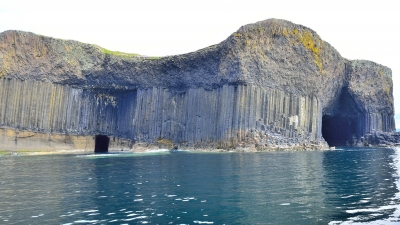
Fingal’s Cave is one of the best known of all the caves in Scotland, and one of the best examples of volcanic basalt columns in the world.
Situated on the uninhabited island of Staffa in the Inner Hebrides, Argyll, Fingal’s Cave is the kind of place that looks like something out of a dream. Looming 227 ft (69 metres) tall over the ocean, this visually astounding geometric sea cave looks like a contemporary masterpiece displayed in the Museum of Modern Art. It has been formed completely from hexagonal columns of basalt, shaped in neat six-sided pillars that make up its interior walls. Many who witness the columns in person insist that they must be man-made. On the contrary, they are completely a gift from nature.
Thanks to the naturally formed arched roof, the echo generated by the smashing ocean waves sings in hypnotic melodic keys. These spine-shivering harmonies are often likened to the sounds heard resonating throughout a cathedral. It must be observed (and heard!) in person to appreciate the uniqueness of this experience!
Fingal’s Cave was created some 60 million years ago by the very same ancient lava flow that created the Giant’s Causeway in Ireland, which is directly across the sea. As both are made of the same basalt columns, legend holds that they were the end pieces of a huge road built by the Irish giant Fionn mac Cumhaill, so he could make it to Scotland where he was to duel with Fingal, his gigantic rival.
Credit : Visit Scotland
Picture Credit : Google




